Rank where it counts: Google Maps, service pages, and city results with a 2025 locksmith SEO plan tailored by an expert agency.
5.0

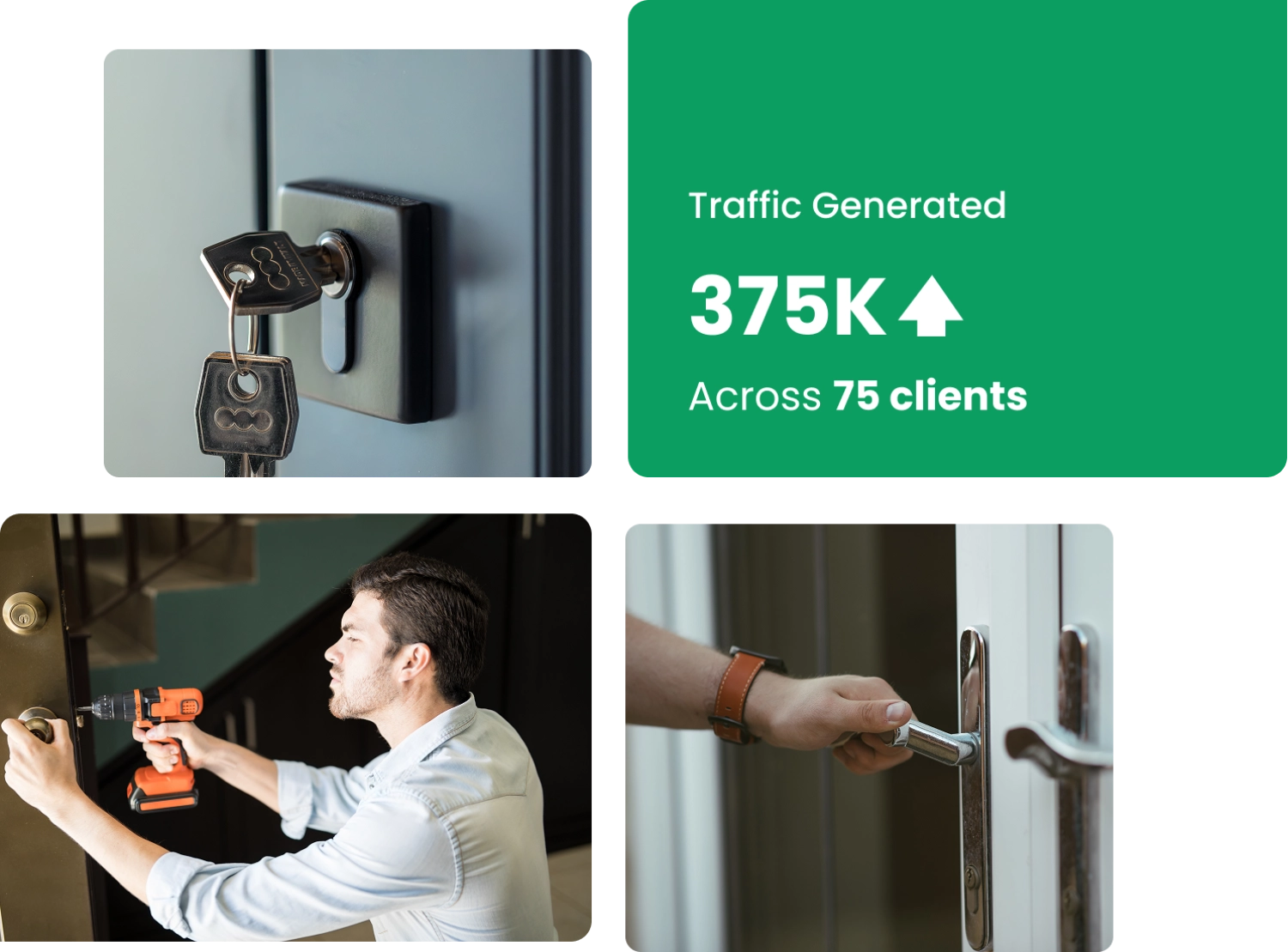

With over 28,000 locksmith businesses across the U.S., staying visible online is tougher than ever. Most locksmiths spend their days handling emergency calls and lockouts, leaving little time for marketing.
Fake listings, rising costs, and seasonal slowdowns only make it harder for real locksmiths to stand out.
That’s where locksmith SEO services can change everything. Done right, SEO generates consistent, high-intent leads directly from Google, eliminating the need for expensive ads.
As a locksmith SEO agency, we’ve helped over 75 locksmiths just like you grow their visibility and leads. The strategies in this guide come straight from the field, tested in 2025, and built to stay effective as search trends evolve.
If you’re tired of paying lead resellers or wasting ad spend, locksmith SEO helps you gain control: driving steady, organic leads without constant ad costs.
Now, let’s go step by step through how to build your locksmith SEO strategy with practical actions that bring real results.
Map out your primary services and service areas. Write down everything you offer and where, like “car lockout in Dallas,” “house rekeying in Chicago,” or “commercial access control in Miami.”
Next, find out the terms people use when they search for those services. You can use tools like Ahrefs, SEMrush, or Google Keyword Planner. If you don’t want to pay for tools, check Google’s People Also Ask section or see what keywords competitors use in their titles and pages.
You’ll come across a lot of keyword ideas, but here’s our suggestion: focus first on high-intent, location-specific keywords.
For example, phrases like “car lockout service in Dallas” or “rekey house locks in Chicago” target ready-to-hire clients. Once you build momentum with those, you can expand to broader locksmith terms later.
In the screenshot below, you’ll see examples of locksmith keywords with local intent and low competition, perfect for starting your locksmith SEO plan.

Here are more keyword examples for “lock installation” you can use to target that specific service:

Note: You can add your service location to the end of all the keywords above.
Those keywords are a great start, but turning them into real traffic takes strategy and consistency. If you’d like expert help finding and using the right ones for your market, our locksmith SEO agency can guide you. Contact us to learn how.
Next, we’ll organize your website for better visibility and easier navigation.
The keywords you found earlier should guide the structure of your website. Website hierarchy is how pages are organized so Google and visitors quickly find what they need.
When someone lands on your site in an emergency, they should instantly see where to go: “lock repair,” “lock installation,” or “emergency locksmith services.” Clear navigation helps them take action fast instead of leaving your site.
Every locksmith website should include these three core pages:
Your navigation bar should include these main pages plus key service pages, like Services, Blog, Reviews, and Projects. See below how a locksmith site uses this structure, with a clear CTA button that drives more calls.
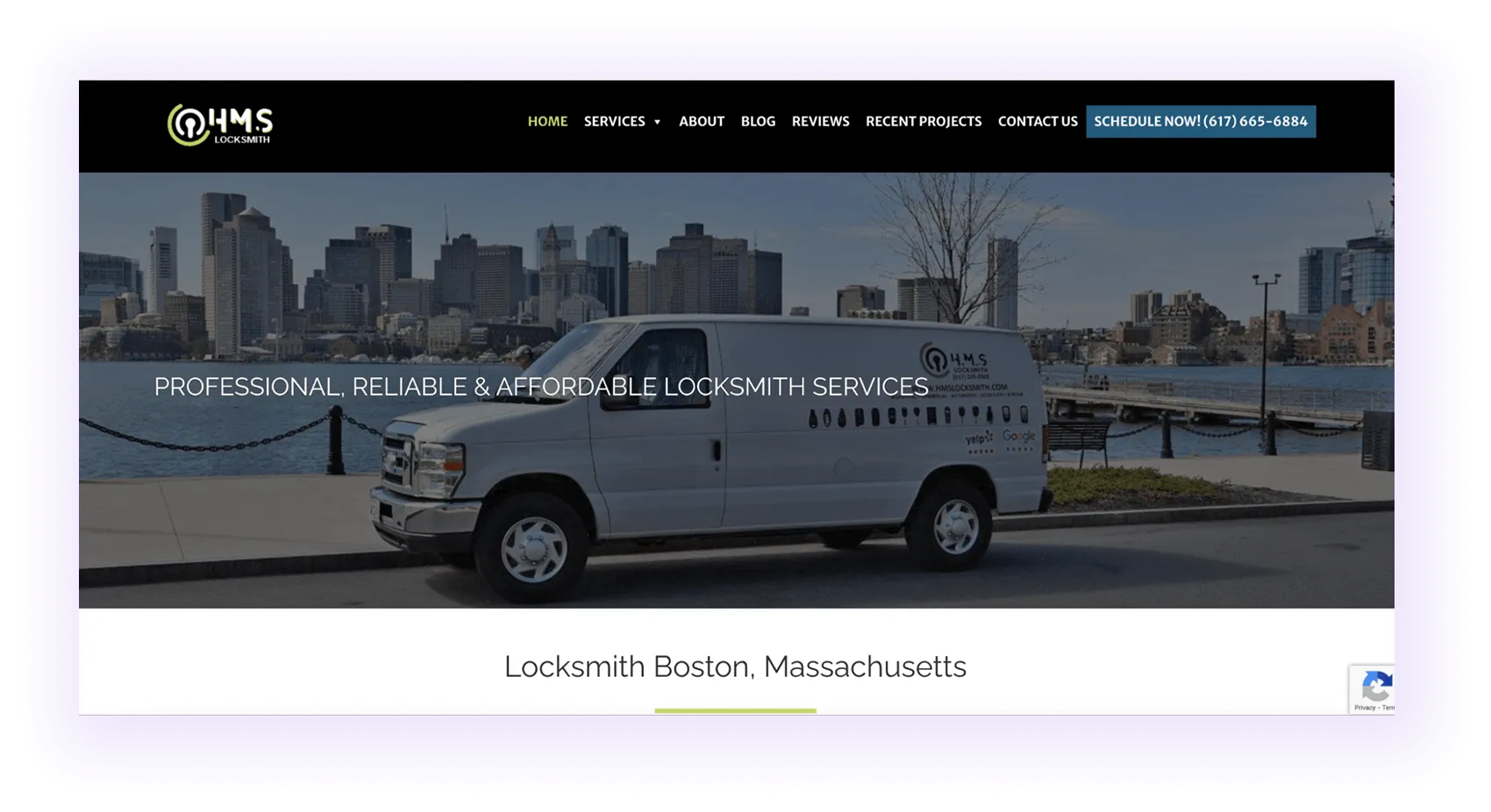
As mentioned earlier, your homepage shouldn’t target specific service keywords. That’s because each service deserves its own page.
You should have a clear “Services” section on your main navigation menu. Under this section, list your specific locksmith services, such as:
Each of these services should have its own dedicated page or section, optimized with relevant keywords and local intent (e.g., “smart lock installation in [city]”).
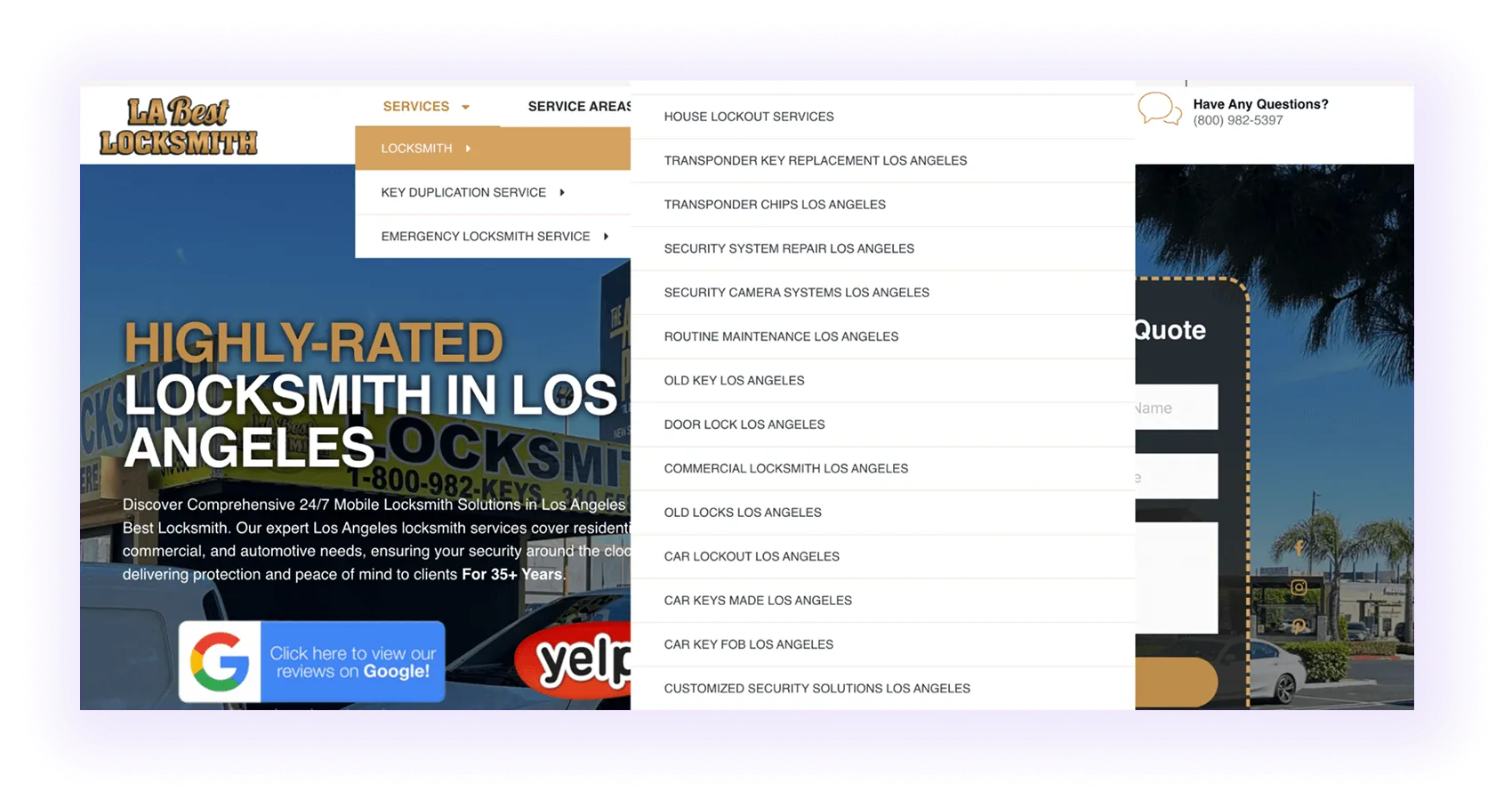
If you provide services for different industries and building types, your locksmith website should include pages for them as well:
Each can include subpages for detailed offerings. For example:
Include these main pages in your navigation bar, and use a simple dropdown to organize subpages. This way, it’s clearer for your customers and search engines.
The screenshot below shows how a locksmith site can set up an easy-to-navigate service menu.

Because most locksmith calls are urgent, people rarely look for national companies. They search for someone nearby who can help fast. To capture that traffic, create individual pages for each city or area you serve. These local pages help you rank in location-based searches and build trust with customers who want a locksmith “near me.”
For example, instead of one general service page, you can create:
You can link these local pages in your main navigation or footer for easy access. The example below shows how a locksmith website features its service areas directly in the footer to boost local visibility.

When someone’s dealing with a lock problem, their first move is usually to Google a quick fix. If that doesn’t work, they start searching for a locksmith. Along the way, they ask questions like “how to fix a jammed door lock” or “why my key won’t turn.”
Publishing blog posts that answer these real problems helps you attract visitors who already need your services. It builds trust, shows your expertise, and often turns readers into clients once they realize they need professional help.
You’ll get the best results by organizing these posts using a topic clustering strategy, which we’ll explain later in this guide.
Stop Guessing Your Locksmith Website Structure—We Will Show You Exactly What Pages You Need
It’s easy to overthink your website layout, or copy what competitors do, and still miss what really drives calls. Our locksmith SEO agency has helped 75+ locksmiths build clear, lead-focused structures. Contact us and we’ll help you do the same.
Now that you know how important it is to target service keywords with locations, the next step is applying that strategy to your business type.
Locksmith companies generally fall into two categories:
Here’s how each should approach local locksmith SEO.
If your locksmith business serves one main area, focus your SEO around that location. Target both general and service-specific keywords combined with your city name, for example:
Use these terms naturally in headings, meta titles, descriptions, and image alt text, but avoid overusing them, since keyword stuffing hurts rankings.
Here’s an example of how a local locksmith effectively targets one area with “locksmith in brooklyn.”
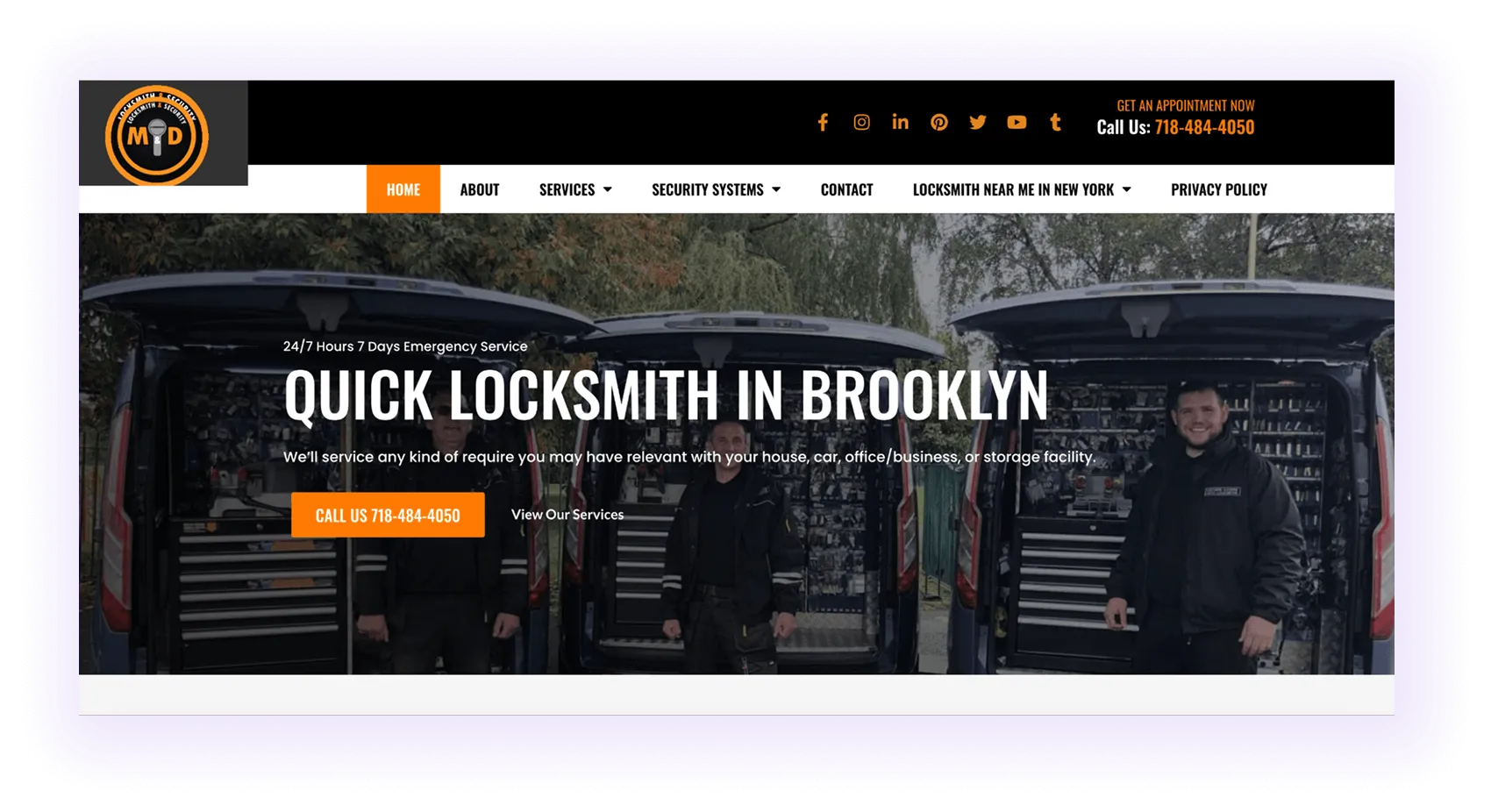
When serving multiple cities or states, build your SEO strategy around location-specific pages. Create a dedicated page for each area you cover, for example:
Add a Location Hub Page linking to all city pages. This helps Google crawl efficiently and makes it easier for users to find their area.

Include main service locations in the footer and navigation bar for quick access by users and search engines.
Pro tip: For stronger indexing and better UX, use a clear URL structure like this example:
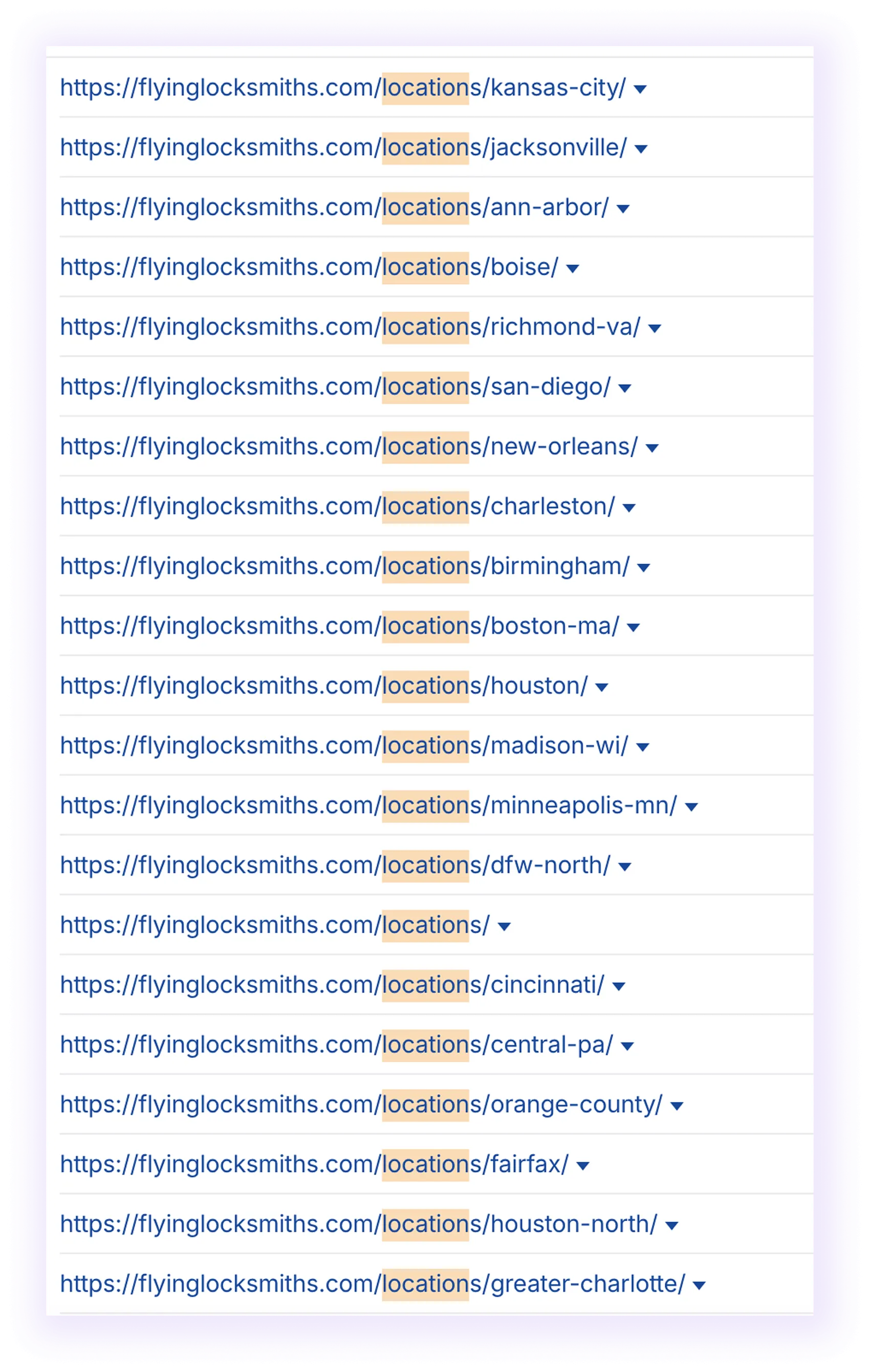
For locksmiths, showing up on Google Maps can make or break your lead flow. When someone searches “locksmith near me” or “locksmith in los angeles,” most calls go to the businesses appearing in the local map packs. To rank there, you need a fully optimized Google Business Profile.
Here’s how to do it right:
Below is an example of a fully optimized Google Business Profile for a locksmith company in Los Angeles.
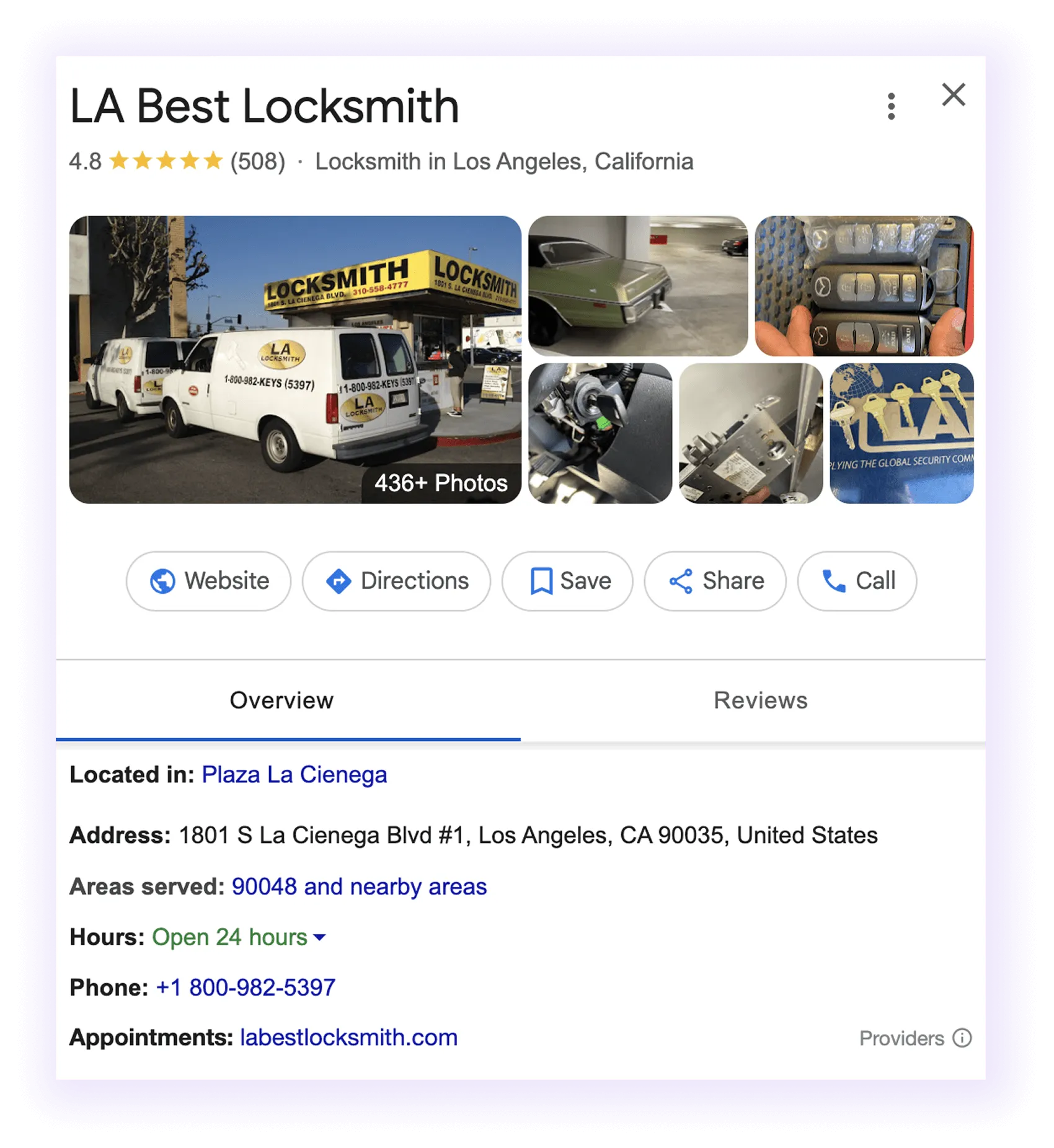

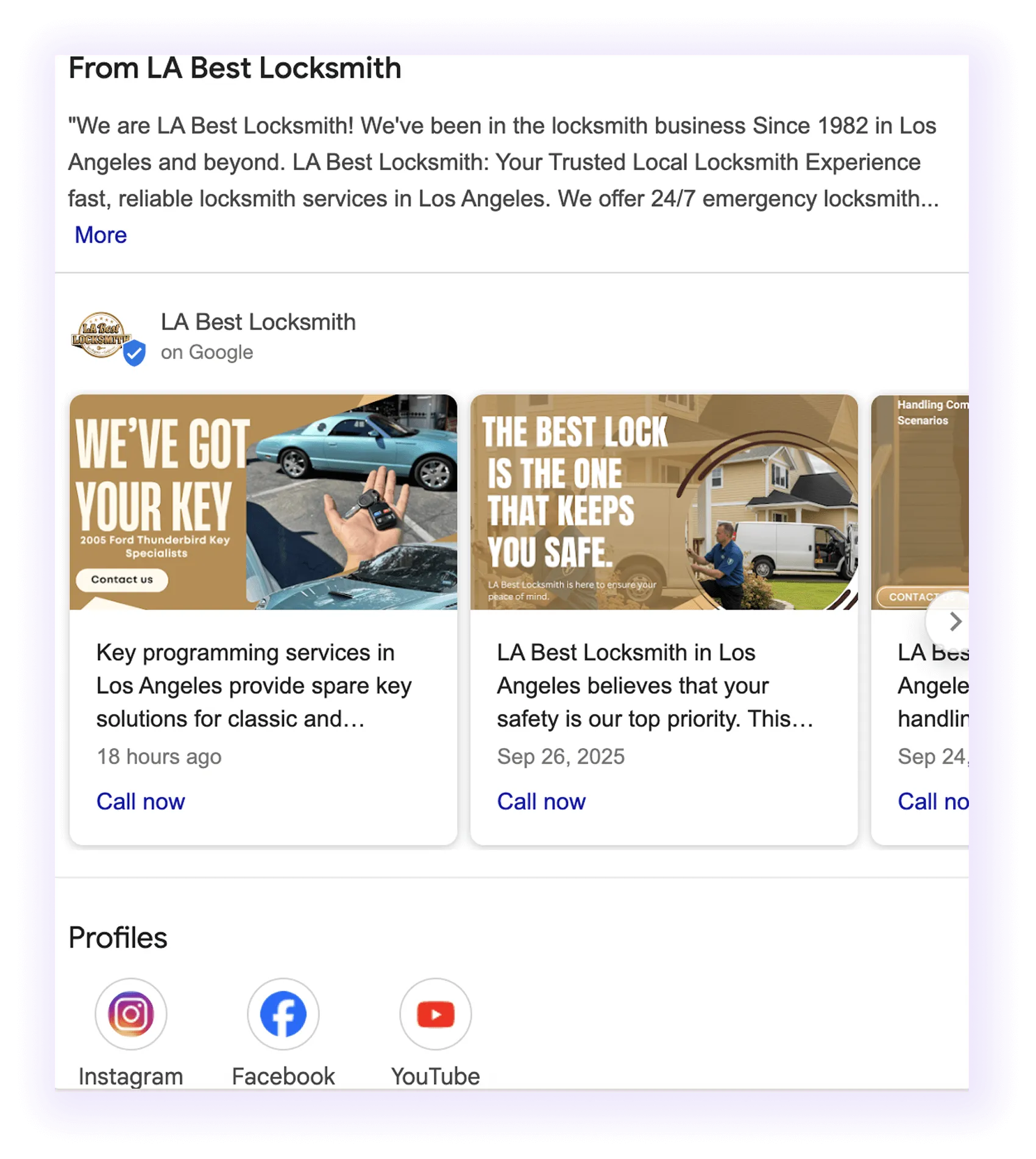
After optimizing your profile, this is how you will show up in Google Maps when people search for “lock installation in los angeles”:
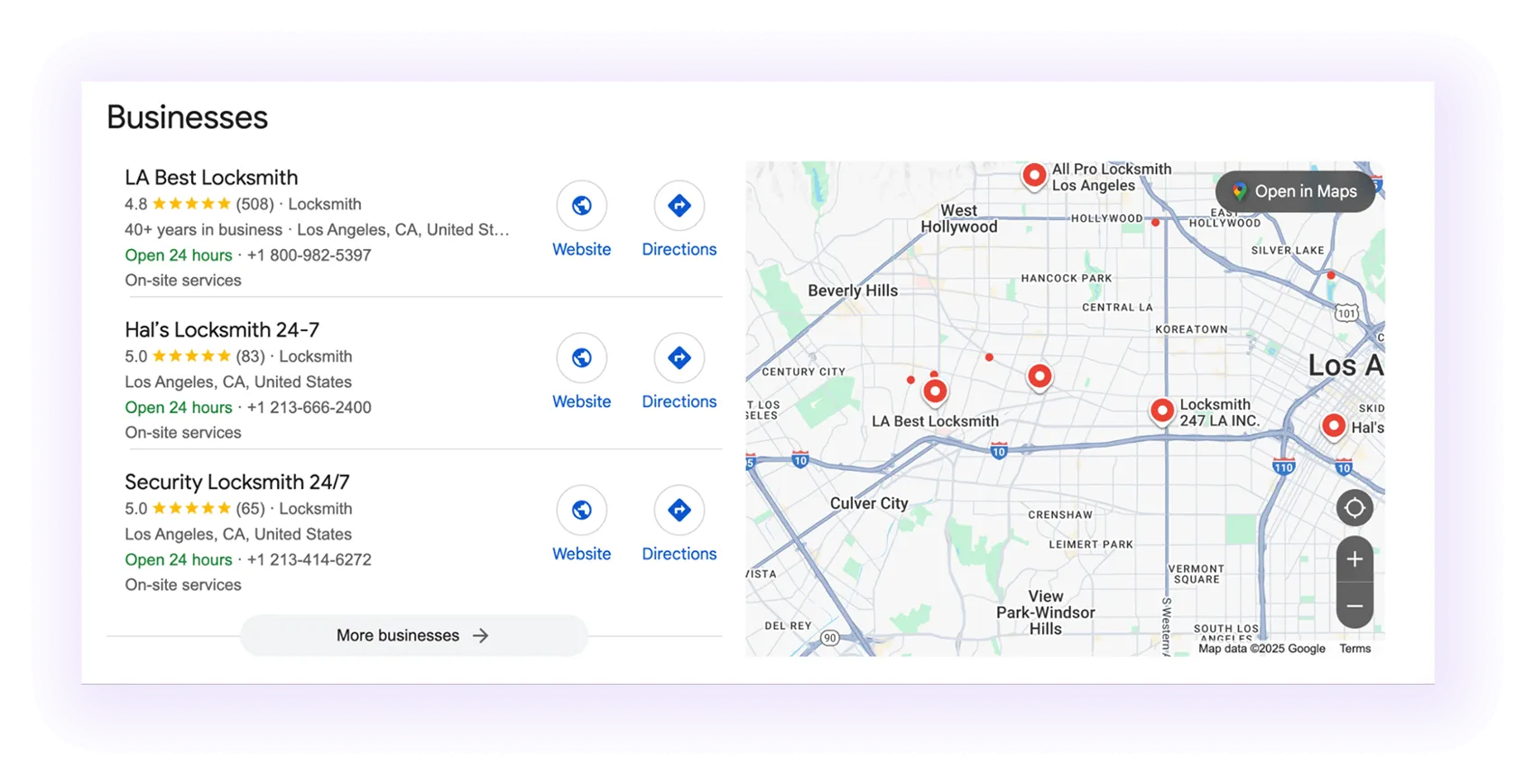
Now that your pages are optimized, the next step is creating strong, trustworthy content. This is what convinces visitors to choose your locksmith service and shows Google that your site deserves to rank.
Your content should prove expertise and help people solve real problems, not fill space. Keep these essentials in mind:
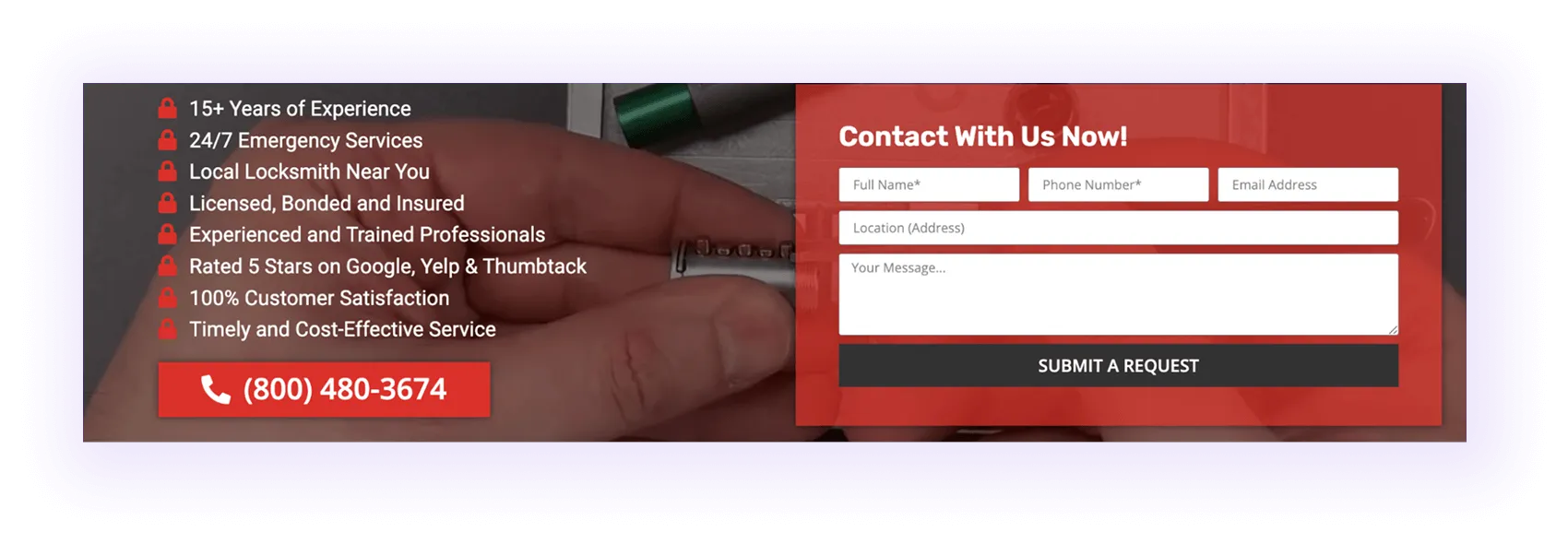




These elements signal to Google that your locksmith business is reliable, expert, and active in serving local clients.
Blog posts help you expand visibility: they let you answer common locksmith questions, build authority, and attract customers who are still deciding what kind of help they need.
This is where you use the topic clustering we introduced earlier. It’s a blog organization method, which essentially means writing several posts around a main service or keyword you want to rank for.
For example, if your core service is “home lock replacement,” you could write:
Link each of these posts back to your main “lock replacement” service page to strengthen its authority.
To find good topics, search your primary keyword in Google and check the People Also Ask and Related Searches sections.
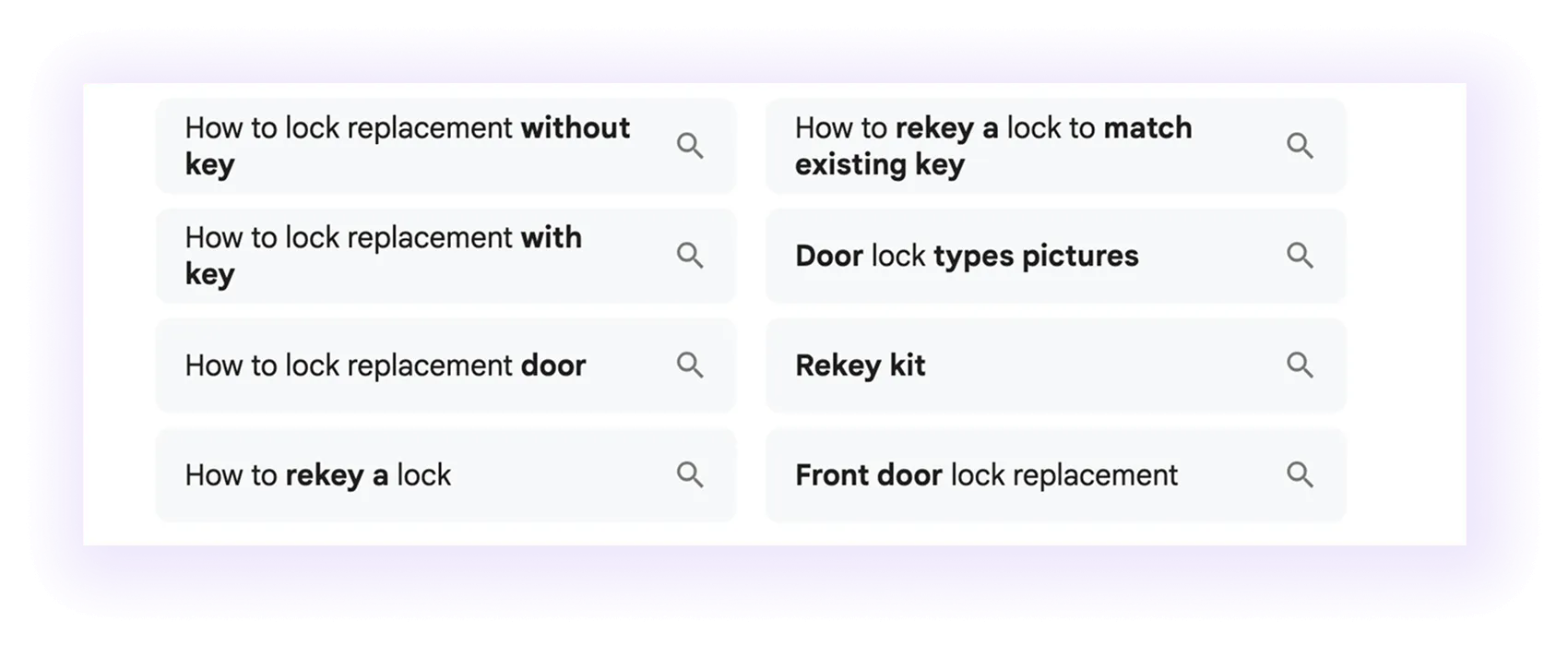
Now we’ll share a few content writing best practices that’ll make your locksmith blogs both useful and easy to read:
Here’s an example:

Now let’s optimize your site on a technical level. If terms like crawling, indexing, or Core Web Vitals sound confusing, they’ll become clearer now. You have to have technical SEO set up, because it’s what helps Google find and rank your site.
Here are the essentials to get right:

Below is an example of an organized sitemap for a locksmith website.
When SEOs talk about schema markup, they’re referring to structured data, a code that helps Google understand your website’s content, the purpose of each page, and the locksmith services you offer.
Using structured data makes your site appear in rich snippets: images, FAQs, ratings, and other enhanced search results. This increases visibility and improves your click-through rates.
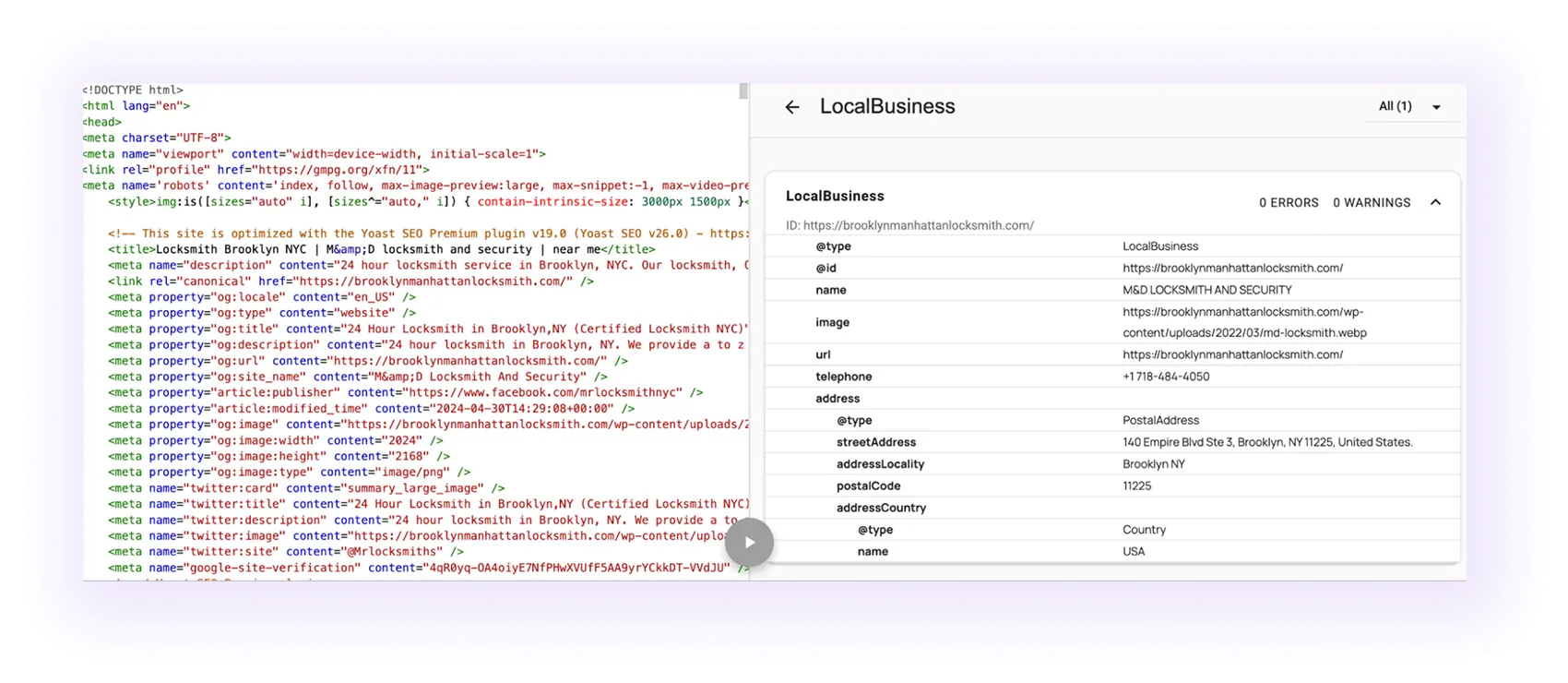
Here are the best schema markups for locksmith companies, simple and short:
Next, you need a clear URL structure that helps both users and Google understand your pages and improves rankings.
Examples:
You also need strong internal linking to help Google understand how your pages connect and share authority between them. This boosts SEO and improves navigation.
Here’s how to do it right:
Example: “front door lock replacement” → “austin locksmith services”
When done well, internal linking makes your website easier to navigate, helps Google understand your site's hierarchy, and enhances overall SEO performance.
Below is an example of how a locksmith site links its services from the main service page.
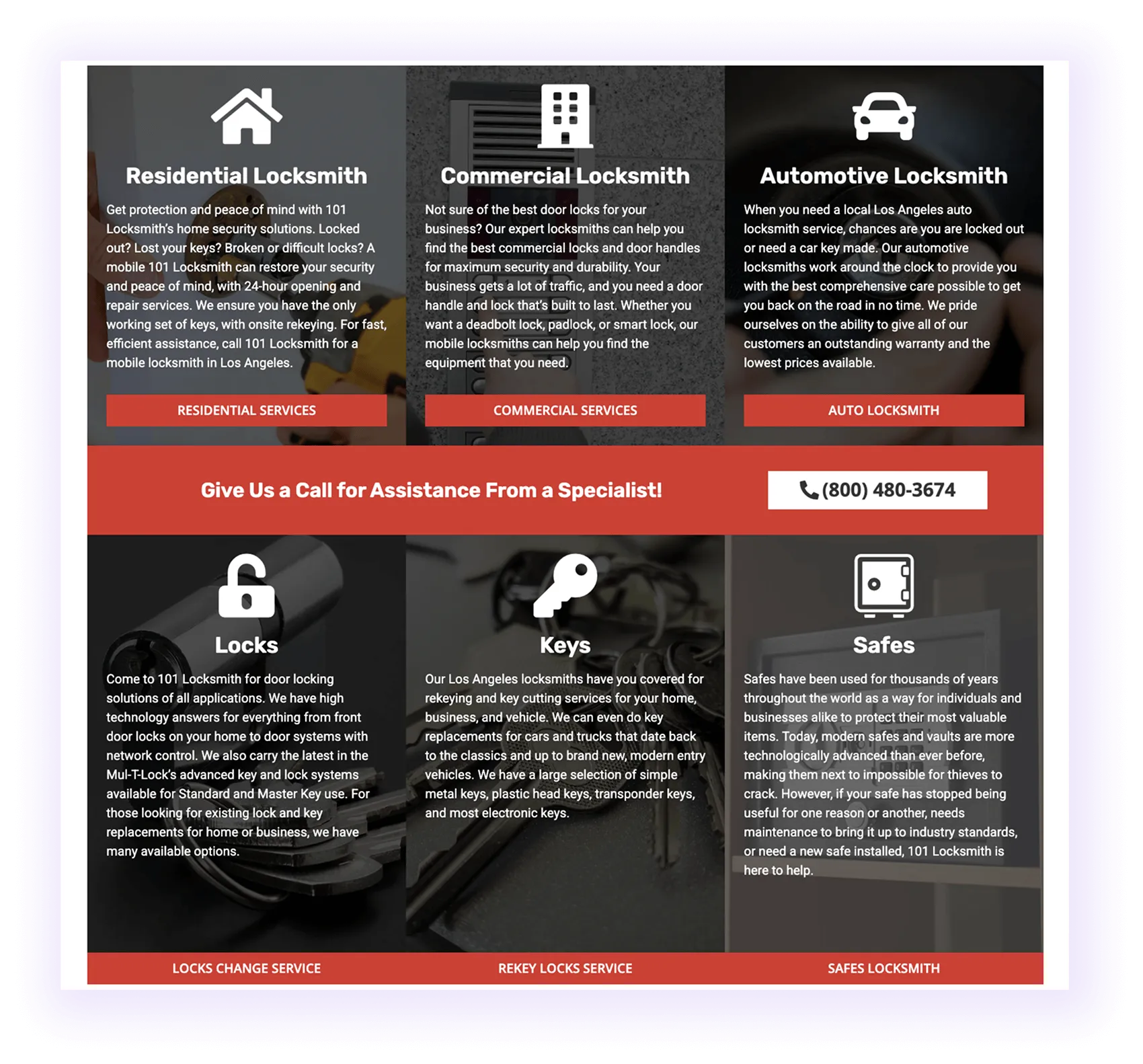
Most lockouts happen when people aren’t near a computer. They grab their phone and search “locksmith near me.” That’s why your site must load fast, look great on mobile, and make it easy to call right away.
Your mobile site should include:

When someone’s locked out, every second counts. If your site takes too long to load, they’ll move on to another locksmith. A fast website improves user experience, conversions, and local rankings.
Ways to improve speed:
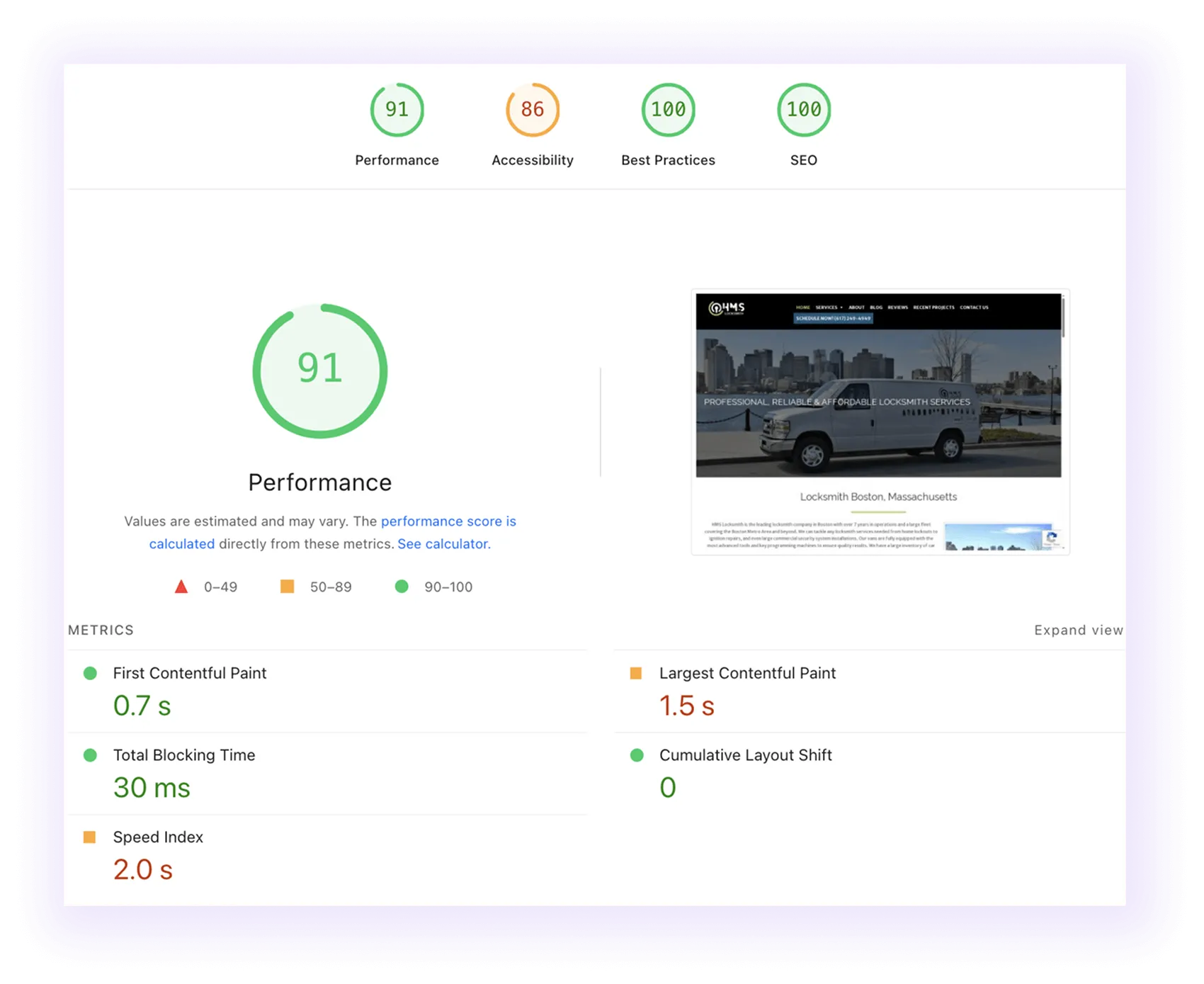
Core Web Vitals targets to aim for:

As your locksmith business grows, you’ll likely add new promotions, case studies, or partnerships. Keeping your website updated is great, but every change can also introduce technical issues that quietly hurt your locksmith SEO.
Use tools like Google Search Console and Screaming Frog to:
If handling audits sounds overwhelming, our locksmith SEO agency can manage the full technical checklist for you, covering over 150 technical SEO items and optimizing them.
We’re almost done, but your locksmith SEO isn’t complete without authority-building. Google trusts websites that others vouch for, and backlinks are that vote of confidence.
When other reputable sites link to yours, it signals reliability and boosts your rankings. But focus on quality over quantity; a few strong links from trusted sources are far more valuable than hundreds of random ones.
For locksmiths, great backlink sources include:
Here are three effective strategies to start building backlinks.
Both help you earn quality backlinks from relevant sites:
Example sites to consider for both:
Because trust is crucial for locksmith clients, being listed on reputable business directories helps prove your legitimacy and strengthen local SEO.
Make sure to:
Directories for locksmiths :
Digital PR is one of the fastest ways to build authority by securing backlinks from major publications or websites that may seem out of reach.
Research topics that interest journalists in home security, construction, or technology. Then pitch useful, newsworthy insights that fit their readers. When chosen and published, even one feature can significantly boost your credibility and SEO.
An example publication you can aim for: https://www.securitysystemsnews.com/
Topic: The hidden weak link in smart locks
If you don’t track results, you can’t improve them. Monitor your keyword rankings, user behavior, authority, and conversions to see what’s working and what’s not.
Check the following:
To do all that efficiently, here’s a comparison of the best tools for locksmith SEO tracking:
At the end of the day, SEO isn’t about clicks; it’s about calls, trust, and steady work.
Our locksmith SEO agency has helped over 75 locksmiths grow visibility and leads through proven strategies. Let’s create the same results for you.
Submit the form - Get Free Proposal
%202.png)
24 hours